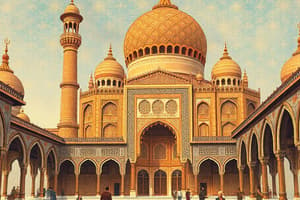Podcast
Questions and Answers
How did the Ottoman Empire change the city of Constantinople?
How did the Ottoman Empire change the city of Constantinople?
- The Empire changed the city's name to Istanbul, made it the capital, and turned an important church into a mosque. (correct)
- The Empire changed the city's name to Istanbul, made it an academic center, and burned all churches to the ground.
- The Empire changed the city's name to Mecca, made it an academic center, and converted an important church into a mosque.
- The Empire changed the city's name to Mecca, made it the capital, and turned an important church into the Taj Mahal.
How did Akbar most help non-Muslims?
How did Akbar most help non-Muslims?
Ending taxes they had to pay.
Which best states why the Mughal Empire was considered a good example of multiculturalism?
Which best states why the Mughal Empire was considered a good example of multiculturalism?
- The Empire conquered several cultures and created a complex government structure to control them.
- The Empire conquered several cultures and created new religions to help them adjust to Islam.
- The Empire brought together several cultures and gained loyalty by giving people many freedoms. (correct)
- The Empire brought together several cultures and gained loyalty by repelling European colonization.
How did the Ottoman Empire respond to non-Muslims?
How did the Ottoman Empire respond to non-Muslims?
Which ruler promoted religious diversity in the Ottoman Empire?
Which ruler promoted religious diversity in the Ottoman Empire?
What is a difference between Babur and Akbar?
What is a difference between Babur and Akbar?
Which best explains how Babur's rule of the Mughal Empire influenced Akbar's rule?
Which best explains how Babur's rule of the Mughal Empire influenced Akbar's rule?
How did Mughal emperor Akbar show respect for religious diversity?
How did Mughal emperor Akbar show respect for religious diversity?
What did Ottoman sultan Suleiman I and Mughal emperor Akbar both do?
What did Ottoman sultan Suleiman I and Mughal emperor Akbar both do?
The Mughal empire blended which three cultures?
The Mughal empire blended which three cultures?
The Taj Mahal was a great ____ structure.
The Taj Mahal was a great ____ structure.
Flashcards are hidden until you start studying
Study Notes
Ottoman Empire Changes
- Constantinople was renamed Istanbul after the Ottoman conquest and became the capital of the empire.
- The city was transformed into an academic center and an important church was converted into a mosque.
Akbar's Policies
- Akbar ended taxes imposed on non-Muslims, improving their status and loyalty within the empire.
- He promoted religious tolerance, creating an environment where different cultures could coexist.
Mughal Empire Multiculturalism
- The Mughal Empire is noted for its multiculturalism, successfully uniting multiple cultures and granting freedoms to gain loyalty.
- The diverse society was not merely controlled by military means but was encouraged to flourish under inclusive policies.
Ottoman Response to Non-Muslims
- The Ottoman Empire offered religious freedom to non-Muslims, allowing them to practice their faith without forceful conversion.
Religious Diversity Leadership
- Mehmed II was instrumental in promoting religious diversity within the Ottoman Empire compared to other rulers.
Babur and Akbar
- Babur, the first emperor of the Mughal Empire, laid the groundwork for a successful dynasty, while Akbar is considered its greatest leader.
- Akbar's rule was influenced by Babur's respect for various religions, which inspired him to foster religious tolerance.
Respect for Religious Diversity
- Mughal emperor Akbar demonstrated respect for religious diversity by easing the enforcement of Islamic law, promoting a more inclusive atmosphere.
Shared Practices of Akbar and Suleiman I
- Both Suleiman I of the Ottoman Empire and Akbar granted religious freedom to non-Muslims, reflecting a shared approach to governance.
Cultural Blending
- The Mughal Empire blended elements of Islam, Sikhism, and Hinduism, resulting in a rich, diverse cultural legacy.
Architectural Achievement
- The Taj Mahal is recognized as a significant Mughal architectural structure, showcasing the empire's cultural and artistic achievements.
Studying That Suits You
Use AI to generate personalized quizzes and flashcards to suit your learning preferences.



